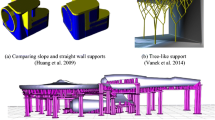Abstract
Over the past three decades considerable amount of research work has been reported in the literature of Group Technology (GT). Most of the research work is concerned with formation of machine cells and part families. This is because cell formation is considered to be the most complex and the most important aspect of Cellular Manufacturing System (CMS). Due to NP completeness of cell formation problem, many heuristics have been developed. These heuristics are developed for both single as well as multiple objectives for the comprehensive cell formation. Here all part types and machine types are considered at a time for cell conversion and that all cells are designed at a single point in time. But planning and implementation of most cell conversions in industry are incremental ones, and not comprehensive. This issue has not been addressed in GT literature adequately. In this paper we consider multiple objectives for incremental cell formation and develop, a lexicographic based simulated annealing algorithm. The performance of the algorithm is tested over several data sets by taking different initial feasible solutions generated using different heuristics.
Similar content being viewed by others
References
BAYKASOGLU, A. and N.N.Z. GINDY. (2000). MOCACEF 1.0: Multiple objective capability based approach to form part-machine groups for cellular manufacturing applications. International Journal of Production Research, 38, 1133–1161.
CHANDRASEKHARAN, M.P. and R. RAJAGOPALAN. (1986). MODROC: an extension of rank order clustering for group technology. International Journal of Production Research 24, 1221–1233.
CHANDRASEKHARAN, M.P. and R. RAJAGOPALAN. (1987). ZODIAC-an algorithm for concurrent formation of part families and machine cells. International Journal of Production Research 25, 835–850.
CHOOBINEH, F. (1988). A framework for the design of cellular manufacturing systems. International Journal of Production Research 26, 1161–1172.
GUPTA, T. and H. SEIFODDINI. (1990). Production data based similarity coefficient for machine component grouping decisions in the design of cellular manufacturing systems. International Journal of Production Research 28, 1247–1269.
GUPTA, Y., GUPTA, M., KUMAR, A. and C. SUNDARAM. (1996). A genetic algorithm-based approach to cell composition and layout design problems.International Journal of Production Research 34, 447–482.
HARHALAKIS, G., NAGI, R., and J.M. PROTH. (1990). An efficient heuristic in manufacturing cell formation for group technology applications. International Journal of Production Research 28, 185–198.
J.R. KING. (1980). Machine-component grouping in production flow analysis: an approach using a rank order clustering algorithm formation in group technology. International Journal of Production Research 18, 213–232.
KIRKPATRICK, S., GELATT, C.D. Jr. and M.P. VECCHI. (1983). Optimization by simulated annealing, Science 220, 671–680.
LEEPOST, A. (2000). Part family identification using a simple genetic algorithm. International Journal of Production Research 38, 793–810.
LOGENDRAN, R., P. RAMAKRISHNA, and C. SRIKANDARAJAH. (1994). Tabu search based heuristics for cellular manufacturing system in the presence of alternative process plans, International Journal of Production Research 32, 273–297.
MAHESH, O. and G. SRINIVASN. (2002a). Incremental cell formation considering alternative machines.International Journal of Production Research 40, 3291–3310.
MAHESH, O. and G. SRINIVASN. (2002b). Algorithms for incremental cell formation problem. Proceedings of Symposium on manufacturing excellence (SYMAX) IIT Madras,183–184
MARSH, R.F., SHAFER, S.M. and J.R. MEREDITH. (1999). A comparison of cellular manufacturing research presumptions with practice. International Journal of Production Research 37, 3119–3138.
MCAULEY, J. (1972). Machine grouping for efficient production. Production Engineer 51, 53–57.
METROPOLIS, N., ROSENBLUTH, A., ROSENBLUTH, M., TELLER, A. and E., TELLER. (1953). Equations of state calculations by fast computing machines. Journal of Chemical Physics 21, 1087–1092.
NAIR, G., JAYAKRISHNAN and T.T. NARENDRAN. (1998). CASE: A clustering algorithm for cell formation with sequence data. International Journal of Production Research 36, 157–179.
NAIR, G., JAYAKRISHNAN and T.T. NARENDRAN. (1999). ACCORD: A bi-criterion algorithm for cell formation using ordinal and ratio-level data. International Journal of Production Research 37, 539–556.
SOLEJA, V.B. and S.M. UROSEVIC. (1969). Optimization of Group Technology lines by methods developed in IAMA, Belgrade. Proceedings of the International Conference on GT, ILO, Turin.
S. SOFIANOPOLOU. (1999). Manufacturing cells design with alternative process plans and/or replicate machines. International Journal of Production Research 37,707–720.
SRINIVASAN, G., NARENDRAN, T.T. and B. MAHADEVAN. (1990). An assignment model for the part-families problem in group technology. International Journal of Production Research 28, 145–152.
Su, C.T. and Hsu, C.M. (1998). Multi-objective machine-part cell formation through parallel simulated annealing. International Journal of Production Research 36, 2185–2207.
VENUGOPAL, V. and T. T. NARENDRAN. (1992a). Cell formation in manufacturing systems through simulated annealing: an experimental evaluation. European Journal of Operational Research 63, 409–422.
VENUGOPAL, V. and T. T. NARENDRAN. (1992b). A genetic algorithm approach to the machine component grouping problem with multiple objectives. Computers and Industrial Engineering 22, 469–480.
WEMMERLOV, U. and N.L. HYER. (1989). Cellular manufacturing in the US: a survey of users. International Journal of Production Research 27,1511–1530.
WEMMERLOV, U. and D. J. JOHNSON. (2000). Empirical findings on manufacturing cell design. International Journal of Production Research 38, 481–507.
ZHAO, C. and Z. Wu. (2000). A genetic algorithm for manufacturing cell formation with multiple routes and multiple objectives. International Journal of Production Research 38, 385–395.
Author information
Authors and Affiliations
Corresponding author
Rights and permissions
About this article
Cite this article
Mahesh, O., Srinivasan, G. Multi-objectives for incremental cell formation problem. Ann Oper Res 143, 157–170 (2006). https://doi.org/10.1007/s10479-006-7379-9
Issue Date:
DOI: https://doi.org/10.1007/s10479-006-7379-9




